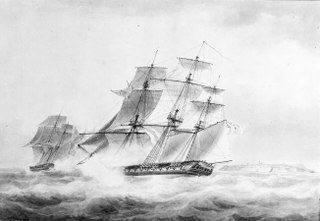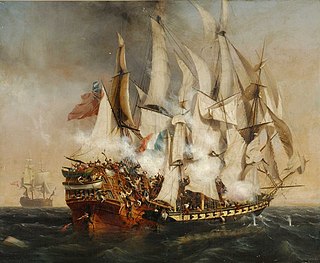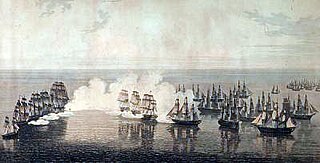
The Didon was a Virginie class 40-gun frigate of the French Navy. Captured by the British in 1805, she went on to serve briefly in the Royal Navy as the 38-gun fifth-rate HMS Didon until she was sold in 1810.

Loire was a 44-gun frigate of the French Navy. She was captured following the Battle of Tory Island by a Royal Navy frigate squadron and subsequently taken into British service as HMS Loire.
Franchise was launched in 1798 as a 40-gun Coquille-class frigate of the French Navy. The British captured her in 1803 and took her into the Royal Navy under her existing name. In the war on commerce during the Napoleonic Wars she was more protector than prize-taker, capturing many small privateers but apparently few commercial prizes. She was also at the battle of Copenhagen. She was broken up in 1815.
Rear-Admiral Robert Henderson was an officer of the British Royal Navy who fought in several colonial actions and operations during his service in the French Revolutionary and Napoleonic Wars. Henderson served in small cruising warships in the West Indies during the early years of the Napoleonic Wars and took part in the invasion and capture of Saint Lucia in 1803 and operations off Trinidad in 1804. In 1810, Henderson commanded HMS Nereide at the Invasion of Île de France and was awarded a pension for his service which he retained until he became a retired admiral in 1838. He died in 1843.
Lynx was a 16-gun brig of the French Navy, name ship of her two-vessel class of brigs, and launched at Bayonne on 17 April 1804. The British captured her in 1807 and named her HMS Heureux. After service in the Caribbean that earned her crew two medals, including one for a boat action in which her captain was killed, she was laid up in 1810 and sold in 1814.
HMS Scorpion was a Royal Navy Cruizer-class brig-sloop built by John King at Dover and launched in 1803. She was the first of the class to be built since the launching of Cruizer in 1797. Scorpion had a long and active career during the Napoleonic Wars, earning her crews three clasps to the Naval General Service Medal when the Admiralty authorized it in 1847, two for single-ship actions. She also took a number of prizes. Scorpion was sold in 1819.
Sword of Honour is a trilogy of novels by Evelyn Waugh, set during the Second World War.
Michael Fitton (1766-1852) was an English lieutenant in the Royal Navy. During his career he made some 30 to 40 captures of enemy, chiefly French, vessels. Despite his notable victory over the French privateer Superbe in 1806, for which he received various honours, including a medal, and his earlier successes, Fitton never received a promotion beyond the rank of lieutenant. Not only did he lack a powerful patron but there is some suggestion that he may, by injudicious conduct early in his naval career, have made a powerful enemy. He died in 1852.
The French lugger Affronteur was launched in 1795 and in 1796-7 participated in the Expédition d'Irlande. In 1803, HMS Doris captured her and she subsequently served the Royal Navy either as a commissioned vessel or, more probably, as His Majesty's hired armed brig Caroline. In 1807 she was either broken up, or became a letter of marque.
His Majesty's hired armed cutter Admiral Mitchell served under two contracts for the British Royal Navy, one at the end of the French Revolutionary Wars and the second at the beginning of the Napoleonic Wars. She participated in several notable small engagements and actions. In 1806 the Admiralty purchased her and took her into service as the Sir Andrew Mitchell in 1807.
The French corvette Bacchante was launched in 1795 as the second of the four-vessel Serpente class of corvettes. She served for almost two years as a privateer, before returning to the service of the French Navy. After HMS Endymion captured her in 1803, the Royal Navy took her in under her existing name as a 20-gun post ship. Bachante served in the West Indies, where she captured several armed Spanish and French vessels before the Navy sold her in 1809.

HMS Acheron was the mercantile New Grove, launched at Whitby in 1799, that the Admiralty purchased in 1803 and fitted as a bomb-vessel. She served in the Mediterranean for about a year. On 3 February 1805 she and Arrow were escorting a convoy from Malta to England when they encountered two French frigates. Arrow and Acheron were able to save the majority of the vessels of the convoy by their resistance before they were compelled to strike. Arrow sank almost immediately after surrendering, and Acheron was so badly damaged that the French burnt her. However, the British vessels' self- sacrifice enabled almost all the vessels of the convoy to escape.
HMS Grenada was the French schooner Harmonie, launched in 1800 and armed at Cayenne in 1803 as a privateer. Boats of a squadron of the British Royal Navy cut her out from the harbour of Le Marin, Martinique, on 16 November 1803. The citizens of Grenada purchased her and donated her to the Royal Navy, which commissioned her in 1804 as HMS Grenada. She was later converted to a brig. She captured nine small French privateers before being sold for breaking up in 1810.

Confiance, launched in 1797, was a privateer corvette from Bordeaux, famous for being Robert Surcouf's ship during the capture of the British East India Company's East Indiaman Kent. The British Royal Navy captured Confiance in 1805, took her into service under her existing name, and sold her in 1810. Before she was sold, Confiance took part in two notable actions.
Ann and Amelia was a three-decker merchant ship launched in 1781. The British East India Company (EIC) twice employed her as an "extra ship", first when she went out to India to sail in trade in that market, and again in 1803 when she sailed back from India to Britain. On her return to Britain the Admiralty purchased her in June 1804 and converted her to a 44-gun fifth rate with the name HMS Mediator. The Navy converted her to a storeship in 1808, but then expended her as a fireship at the battle of the Basque Roads in April 1809.

The Raid on Samaná was a land and naval action where two Royal Navy ships attacked the French held port of Samaná in Santo Domingo on 14 February 1807 during the Napoleonic wars. They captured and burned a fort and then captured a number of ships which included two prizes with only light losses.
Henry Addington was launched in 1800 as an East Indiaman for the British East India Company (EIC). She made seven voyages for the EIC before she was sold in 1815 for breaking up. She was one of the vessels at the battle of Pulo Aura in 1804.
HMS Matilda was the French privateer Matilde, which HMS Cambrian captured in 1805. The British Royal Navy used her briefly that year. She is last listed in 1805.
HMS Phosphorus was the Dutch naval vessel Haasje that the Royal Navy captured in 1803 and took into service in 1804 as a fireship. She took part in a notable single-ship action in 1806. The Navy sold her in 1810.








